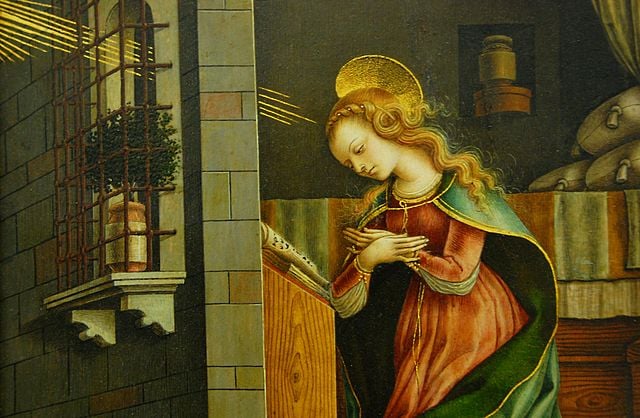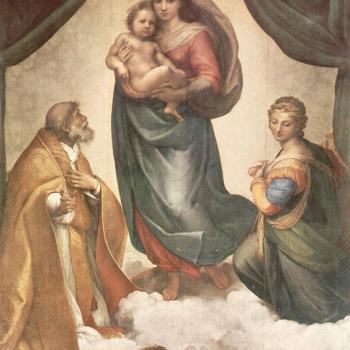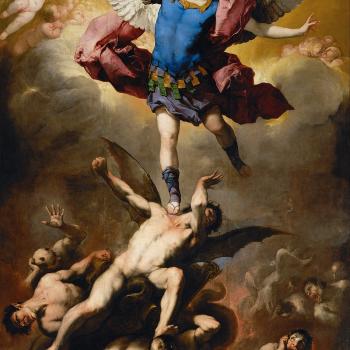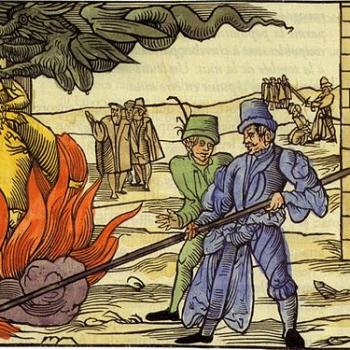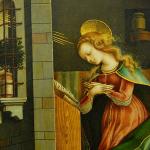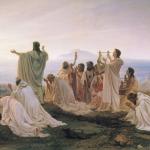Jason Engwer is a Protestant evangelical anti-Catholic apologist who runs the Triablogue site. I’ve critiqued his articles many many times (see his name on my Anti-Catholicism page), but he has refused to counter-reply since 2010 (having done so for the previous eight years), and of course he bans me from his site. What else is new? In any event, it’s still well worth spending time refuting error that is influencing many people, because falsehoods don’t do anyone any good. I use RSV for Bible citations. Jason’s words will be in blue.
*****
I’m replying to Jason’s article, “How Early Activities, Not Just Early Language, Contradict Mary’s Perpetual Virginity” (6-1-25).
The marriage between Joseph and Mary is evidence against her being a perpetual virgin, . . .
It’s not at all, in and of itself, because it was absolutely unique in all of human history: being a mother and a father figure to God incarnate. Most Christians throughout history have regarded it as fitting and proper that the womb that carried God the Son should not bear any other human being. One either spiritually and intuitively grasps this or not (see my “holy ground” argument).
Those who don’t accept this outlook usually fall back on the old, tiresome, “Catholics are against sex and think it’s dirty” argument. We’re not (we regard marriage as a sacrament, after all), but beyond that canard, we’re not the only ones who believe in Mary’s perpetual virginity in the first place. Martin Luther did; John Calvin did, Zwingli did; as did all of the earliest Protestant leaders. Many excellent and renowned Protestant exegetes and commentators throughout history have believed in it; as does the Orthodox Church; and the Church fathers massively held to it.
Marriage wouldn’t have to involve sexual activity, but encourages it, typically involves it, and typically does so as a significantly prominent part of the relationship.
That’s the whole point. Of course, “typically” a marriage includes sexual relations, but this marriage was anything but typical. Thus, Jason — almost despite himself — concedes the possibility of Mary’s perpetual virginity even by the language he uses. He can’t avoid it.
If there was a desire for a mother/father setting for the raising of Jesus, a desire on God’s part or on the part of Joseph and Mary, why not think there was also a desire for the usual human experience of having siblings, most often siblings from the same parents . . .?
Because, again, Jason refers to “the usual human experience.” The Holy Family is not that. It’s an exception to the rule. The Bible is filled with odd things: talking donkeys (the Balaam story), Jacob wrestling with God, Nebuchadnezzar eating grass like cattle; even weird sexual things (since Jason wants to make this issue all or primarily about sexuality): God commanding the prophet Hosea to marry both a prostitute and a promiscuous married woman in order to create an analogy to Israel’s unfaithfulness:
Hosea 1:2-3 . . . the LORD said to Hose’a, “Go, take to yourself a wife of harlotry and have children of harlotry, for the land commits great harlotry by forsaking the LORD.” [3] So he went and took Gomer the daughter of Dibla’im, and she conceived and bore him a son.
Hosea 3:1 And the LORD said to me, “Go again, love a woman who is beloved of a paramour and is an adulteress; even as the LORD loves the people of Israel, though they turn to other gods and love cakes of raisins.”
Or how about God commanding the prophet Isaiah to walk around naked for three years (Is 20:2-4)? King Solomon “had seven hundred wives, princesses, and three hundred concubines” (1 Kgs 11:3). This doesn’t even seem to be condemned in and of itself, in context. What is clearly condemned is the fact that “his wives turned away his heart after other gods; and his heart was not wholly true to the LORD his God” (11:4). His father King David had at least eight wives, and many other concubines as well.
If all those things could happen, sanctioned or allowed by God, why is it unimaginable or considered to be utterly implausible that the other extreme could also happen and be God’s will: namely, a marriage designed from the start to be very different and celibate, because the child involved was 1) already supernaturally conceived by the Holy Spirit, and 2) was God incarnate? Jason loves making all of these anti-traditional and anti-biblical arguments from plausibility and analogy.
I return the favor. I love analogical argument and arguments from plausibility, so it’s a pleasure for me. But we can assuredly turn the tables on all of these arguments he comes up with. As an extra bonus, I also believe in dialoguing with opposing views. Jason does not: at least not with me, and he seems to not do it much at all anymore.
If there was a desire to avoid what’s involved in having other children, in order to focus on Jesus,
That’s not the reason usually given when we defend this; rather, it’s a question of propriety and fittingness. The latter concept is a biblical one.
then why did Mary have a husband with several children from a previous marriage?
Since the premise was wrong, the question is irrelevant. But western Catholics usually believe in the “cousins” explanation, which is grounded in the Bible itself, as opposed to early tradition, as I will show below.
As the New Testament passages about those other children illustrate, Jesus’ siblings were often involved in Joseph and Mary’s lives, including in opposition to Jesus. The most straightforward way to take the marriage between Joseph and Mary is that it involved the usual sexual relationship . . .
Think of how Jesus’ brothers are sometimes referred to as being with Mary and are mentioned just after her (Matthew 12:46, John 2:12, Acts 1:14). Cousins or older children from a previous marriage of Joseph could be with Mary and keep getting mentioned just after her, but younger siblings offer the most efficient explanation. Not only would later children born of Mary best explain the “brothers” language, but they’d also be the best candidates for individuals mentioned just after Mary and referred to as being with Mary (younger siblings of Jesus being better candidates for being with Mary because of their younger age, their closer relationship with Mary, and the efficiency of explaining their group activities by their living in the same house rather than different ones). Similarly, when the people of Nazareth mention Jesus’ brothers and sisters (Matthew 13:55-56), later children of Mary offer the best explanation for why they’d bring up those brothers and sisters. The surrounding context is focused on Jesus’ immediate family (the mentioning of Joseph, the mentioning of Mary), so brothers and sisters from his immediate family would make the most sense in that context. . . .
And notice the cumulative effect. It’s very unlikely that more distant relatives of Jesus (not younger siblings born of Mary) would happen to keep appearing in contexts that would more naturally involve younger siblings born of Mary. Are we to believe that Mary kept appearing, in multiple contexts, with the same more distant relatives and that the people of Nazareth chose to mention the same type of relatives outside Jesus’ immediate family (“brothers”, “sisters”) just after mentioning members of his immediate family, all the while leaving out other relatives outside his immediate family?
I answered this argument over seven years ago in my article for National Catholic Register, entitled, Jesus’ “Brothers” Always “Hanging Around”: Siblings? Here are some highlights:
The Hebrew “household” (if not virtually always) often would contain extended family members. It was not like our nuclear families of today. For example, in the book, Families in Ancient Israel(Leo G. Perdue, editor; Westminster John Knox Press, 1997) we find this description:
The familial roles of males in the household’s kinship structure included those of lineal descent and marriage — grandfather, father, son, and husband — and those lateral relationships — brother, uncle, nephew, and cousin. (pp. 179-180)
The household often even extended to sojourners or hired laborers (ibid., p. 199). In this book, the “household” is casually described as including cousins. For example:
The line of responsibility to serve as the household’s or clan’s “goel” began with the brother, then the uncle, then the cousin, and, finally, any close relative. (p. 192; goel = “redeemer,” or the one “responsible for the justice and well-being of the family”)
The Eerdmans Bible Dictionary (edited by Allen C. Myers, Grand Rapids, Michigan: Eerdmans, rev. ed., 1975) makes the nature of the Israelite family very clear, by noting that it could include more than one nuclear family (thus, cousins would be residing together):
The basic social unit, comprised of persons related by kinship and sharing a common residence. The Israelite family was an extended family known as the “father’s house” or “household” (Heb. “bet-ab”), consisting of two or more nuclear families (i.e., a married couple and their children) or composite families (an individual with multiple spouses and their offspring) . . . other kin (including grandparents), servants, concubines, and sojourners might also be reckoned part of the household (cf. Gen. 46:5-7, 26). (“Family,” p. 376)
Moreover, on the next page, this reference work noted that clans also usually “occupied the same or adjacent towns.” Extended families stuck together. It was like a perpetual family reunion. This would account for first or second or third cousins (all referred to as “brothers” in Semitic or Near Eastern culture: then and now) “hanging around” in one place.
Because Jason and many Protestants and Catholics alike don’t understand this, nor the general use of “brother” for almost any relative or even a fellow Israelite, they are quick to assert the existence of siblings of Jesus. Well, I have fourteen questions for him and those who agree with him, too, if they believe these people are Jesus’ siblings:
1) Why is it that the New Testament never uses the phrase “son[s] of Mary” or “son[s] of Joseph” for anyone besides Jesus?*2) “Son of Mary” appears once, in Mark 6:3 (RSV), referring to Jesus, and interestingly enough, in the same verse He is called “brother of James and Joses and Judas and Simon,” and people say, “are not his sisters here with us?” Yet none of them are called “sons / daughters” of Mary or Joseph. Why not?*3) Why is it that “sons of Mary” never appears in the NT?*4) Why doesn’t the phrase, “Mary’s sons” ever appear in the NT, either?*5) How come “daughter[s] of Mary” never appears?*6) Why don’t the words, “Mary’s daughter[s]” ever appear in the NT?*7) “Son of Joseph” (referring to the carpenter from Nazareth) appears twice (Jn 1:45; 6:42): both referring to Jesus. “Sons of Joseph” appears once (Heb 11:21), but unfortunately for deniers of Mary’s perpetual virginity, it refers to the patriarch Joseph. Why is that, if these are his sons (either supposedly with Mary or from a previous marriage)?
*8) Why is it that “Joseph’s sons” never appears?*9) How come “Daughter[s] of Joseph” never appears, wither?*10) Why doesn’t “Joseph’s daughter[s]” appear in the NT?*11) Why are none of these supposed siblings mentioned when Jesus went to Jerusalem at age 12 and His parents were looking for Him? Are we to believe that Mary waited more than twelve years to have more children?*12) How come Mary is never called the “mother” of these alleged siblings of Jesus, whereas she is called Jesus’ “mother” (Jn 2:1; 19:25)?*13) Why is it, again (see #2) the case that in the following two passages, these “brothers” were mentioned but Mary wasn’t called their mother; only Jesus‘ mother?
*Matthew 13:55 “Is not this the carpenter’s son? Is not his mother called Mary? And are not his brothers James and Joseph and Simon and Judas?”*Acts 1:14 All these with one accord devoted themselves to prayer, together with the women and Mary the mother of Jesus, and with his brothers.*14) Strikingly, it looks like every time St. Paul uses adelphos (unless I missed one or two), he means it as something other than blood brother or sibling. He uses the word or related cognates no less than 138 times in this way. Yet we often hear about Galatians 1:19: “James the Lord’s brother.” 137 other times, Paul means non-sibling, yet amazingly enough, here he must mean sibling, because (so we are told) he uses the word adelphos? That doesn’t make any sense. Why would he do that?
*
Ellicott’s Commentary for English Readers: Supposing him to have been in the company.—The company was probably a large one, consisting of those who had come up to keep the Passover from Nazareth and the neighbouring villages. It is not certain, but in the nature of things it is sufficiently probable, that the boys of such a company congregated together, and travelled apart from the others.
Barnes’ Notes on the Bible: Supposing him to have been in the company – It may seem very remarkable that parents should not have been more attentive to their only son, and that they should not have been assured of his presence with them when they left Jerusalem; but the difficulty may be explained by the following considerations:
1. In going to these great feasts, families and neighbors would join together, and form a large collection.2. It is not improbable that Jesus was “with” them when they were about to start from Jerusalem and were making preparations. Seeing him then, they might have been certain as to his presence.3. A part of the company might have left before the others, and Joseph and Mary may have supposed that he was with them, until they overtook them at night and ascertained their mistake.
Expositor’s Greek Testament: A company would be made up of people from the same neighbourhood, well acquainted with one another. . . . It is quite conceivable how they should have gone on so long without missing the boy, . . .
*
Good point about the brothers repeatedly cropping up in contexts with Mary. I think the John 2:12 context is especially significant, since they seem to be just hanging out with Mary and Jesus there. A Catholic might argue that when the “brothers” are involved in staging an intervention because they think Jesus has gone crazy, this could be whatever other male relatives were alive at that point in a society where kinship was a big deal. But why would they just sort of be there spending time with Mary, Jesus, and whatever disciples Jesus had called by that early point in his ministry, as in John 2:12, if they were just relatives?
1) in comparing Matthew 27:56, Mark 15:40, and John 19:25, we find that James and Joseph (mentioned in Matthew 13:55 with Simon and Jude as Jesus’ “brothers”) are the sons of Mary, wife of Clopas. This other Mary (Mt 27:61; 28:1) is called Our Lady’s adelphe in John 19:25. Obviously, there are not two women named “Mary” in one family.*One opinion, based also on some early patristic evidence, that I hold myself, is that this second Mary was the Blessed Virgin Mary’s sister in-law (Clopas being Joseph’s sibling). In this scenario, a sister-in-law is called “sister” in the NT (which we often do today in our own culture). In any event, we know for sure, from the above information, that James and Joseph were not Jesus’ siblings. They were likely His first cousins, or possibly more distant cousins.*2) Jude is called the Lord’s “brother” in Matthew 13:55 and Mark 6:3. If this is the same Jude who wrote the epistle bearing that name (as many think), he calls himself “a servant of Jesus Christ and brother of James” (Jude 1:1). Now, suppose for a moment that he was Jesus’ blood brother. In that case, he refrains from referring to himself as the Lord’s own sibling (while we are told that such a phraseology occurs several times in the New Testament, referring to a sibling relationship) and chooses instead to identify himself as James’ brother. This is far too strange and implausible to believe.
*3) Moreover, James also refrains from calling himself Jesus’ brother, in his epistle (James 1:1: “servant of God and of the Lord Jesus Christ”): even though St. Paul calls him “the Lord’s brother” (Gal 1:19).*4) Most significantly, Jesus Himself referred to His “brothers” as “kin” or “cousins”:*Mark 6:3-4 Is not this the carpenter, the son of Mary and brother of James and Joses and Judas and Simon, and are not his sisters here with us?” And they took offense at him. [4] And Jesus said to them, “A prophet is not without honor, except in his own country, and among his own kin, and in his own house.”
“Kin” is a translation of the Greek word, suggenes / συγγενής which means “relative” and can also mean “cousin” according to Strong’s Exhaustive Concordance. See Strong’s word #4773 . KJV translates it as Mary’s “cousin Elisabeth” in Luke 1:36 and “her cousins” in Luke 1:58, and elsewhere usually as “kinsmen” but never “brother.” NASB usually renders it “relatives” (and “kinsmen” a few times, too).*I submit, then, that Jesus is referring to some of His named “brothers” in Mark 6:3 as cousins or non-sibling relatives in Mark 6:4, by referring to them as suggenes / συγγενής (“kin” in RSV). The idea ties in with John 7:5: “For even his brothers did not believe in him.” Thus, they are mentioned in the scene in Nazareth where Jesus was rejected, and so Jesus noted that a “prophet” didn’t receive “honor” from “his own kin.” They later likely became believers, but at this point, before the Holy Spirit was given, they didn’t yet “get” it.


